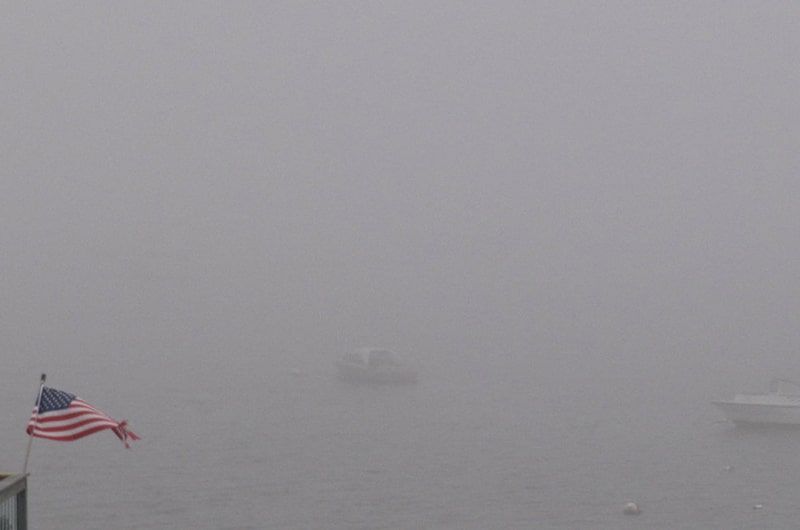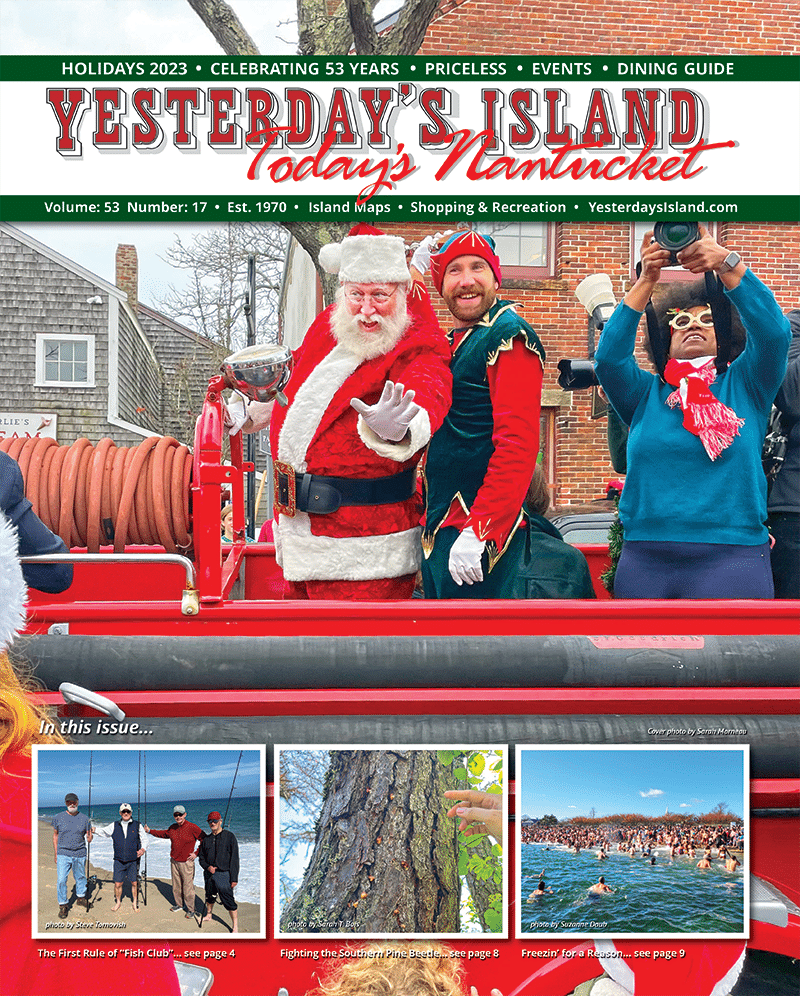by Robert P. Barsanti
The Fourth of July slips onto Nantucket under cover of fog and in a long series of jammed ferry boats. Then, on a someday around noon, we find ourselves stuck in traffic by the high school in front of New Jersey and behind Connecticut. The Fourth is a week when “we have to put our mind on how to crowd and still be kind.”
This year, the holiday brings a richer dread. The happy traditions of the water fights, the pie eating, and the fireworks will happen when the rest of the nation is staring at the mirror in wonder, shame, and shock. The wet crowd of white faces will still smile on Main Street, but may God protect the MAGA hat-wearing Patriot and the Honduran dishwasher.
Out here, the Fourth of July has always required a willful act of disbelief and an ignorance of history. From thirty miles out, America is hard to see. In the course of human events, Nantucket tried to remain neutral in the Revolutionary War and was, if anything, more inclined to the British side than to the Mainland. The Quakers loved silver more than flags—they would have been in favor of whichever flag would bring in the most silver. At the end of a long war and an annihilated whaling fleet, Nantucketers stumbled and grumbled into the new country.
America is not a country so much as it is an idea—and that idea could be a hope or a lie depending on where you sit. “One nation, indivisible, with liberty and justice for all” doesn’t quite have the same sound in the plantations of Alabama, the slums of St. Louis, or the detention facilities in Texas as it does on our sunny and wet cobblestoned Main Street. Our Fourth of July walks soaking and dripping out of a Rockwell illustration; we mustn’t be fooled into thinking it is that way for everyone, even on-island. We are surviving a hard year. The difficulties of this year are not special; the challenge of seeing America has always existed. What makes this year different and difficult is that we cannot look away.
In 1942, though, we looked away. Granted, Germany and Japan grabbed our attention, but Executive Order 9066 was not the most American of moments. With that piece of paper F.D.R. forced the relocation of 125,000 Japanese Americans to desolate prison camps. One of those camps, Manzanar, fenced in 10,000 Americans in the Owens Valley, on the northern edge of the Mojave Desert and on the eastern slope of the Sierra Nevada. In the winter, the temperature would fall into the upper thirties and in the summer, the desert would heat into the hundreds.
History remembers these victims. Ansel Adams and Dorothea Lange took pictures of the imprisoned families, against the backdrop of desert and mountains. Dorothea, the photographer who captured the Depression so well, captured the tragedy of the removal from homes, the suitcases, the buses, the trains, and, finally, the camps themselves: whipped by wind, drifted in dust, and baked by the desert. She captured it so well that the government buried her pictures for decades.
Ansel Adams’ pictures did not get buried. Photographing at the camp, he portrayed the inmates in a heroic light, often against the backdrop of the Sierra mountain range. His subjects look directly into the camera and smile or pose. While it might be propaganda, Adams appears to have been very impressed by those that he met. When he gave the images to the National Gallery, he wrote that the images “show how these people, suffering under a great injustice, and loss of property, businesses, and professions, had overcome the sense of defeat and despair…”
In modern America, we identify with the victims. When I read about Manzanar and saw the photographs, I imagined what I might do if I was imprisoned in one of these camps. In the words of the victims, I hoped to show “Gaman” (enduring what seems unbearable with dignity and grace) and “Shikata Na Gain” (one should not concentrate on the things one cannot change). Of course, as a middle-aged white man, this is a generous self-deception. I no more fit among those young Japanese faces than I would fit among the young Guatemalan faces in the cages in Texas. My race and gender puts me on the other side of that fence.
At Manzanar, Ralph Merritt also stood on the other side of the fence; he ran the camp. A middle-aged white man, he left a career in raisins to serve the war effort in the Owens Valley, at the feet of the Sierra Nevada. Nobody took his picture and history has forgotten him, save for one oral history project and a garden in desert. But that garden was a remarkable space. The Pleasure Garden in Block 22 began as a project among the imprisoned Japanese, but it became the way to bring the jailed and the jailor together. The jailed left the grounds to scour for trees and flowers to bring inside the fence: the jailers snuck material through the bureaucracy. The Pleasure Garden (in the Mojave) eventually included several ponds, rock gardens, a rustic bridge, teahouses, a waterfall, and roses. Merritt was so proud, he took home movies of it and invited Ansel Adams to photograph it. Before the camps was disbanded, the builders renamed Pleasure Park after Ralph Merritt. Other then Merritt Park, history does not remember him. And the desert has reclaimed the roses.
I harbor few illusions about Ralph. I am sure that he was a man of his time, seeped and stewed in the prejudices and small mindedness of a fiftyyear- old white man caught in a great war. But when he was tested, he stood up, burned bright, and illuminated a shadowy and foggy America. Like a more famous American, he “saw wrong and tried to right it, saw suffering, and tried to heal it, saw war and tried to stop it.”
America is hard to see. We hope that it lies out there, where Ralph Merritt left it, beyond the waves and mist: “One nation, indivisible, with liberty and justice for all.”



